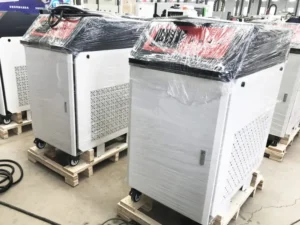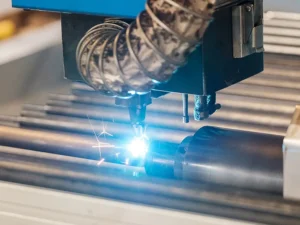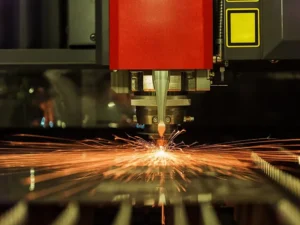Introduction:
Laser welding technology has revolutionized the manufacturing industry, offering precise and efficient joining of materials. However, the cost of implementing laser welding equipment is a significant factor that businesses need to consider.
How much does a laser welder cost? In this article, we talk about this and will also explore the factors that influence the cost of a laser welder, including machine type, power, and additional features. By understanding these factors, individuals and businesses can make informed decisions about investing in laser welding technology.
How Much Does a Laser Welder Cost?

The answer to the question of how much a laser welding machine costs can vary significantly based on several factors, including the type of laser technology, power output, configuration, and additional features. Considering these factors, the laser welding machine price can range from a few thousand dollars for entry-level, lower-power systems to hundreds of thousands of dollars for high-power, industrial-grade models with advanced capabilities.
To have a rough idea as to how much a low-level, mid-level, and high-level laser welder costs, we have put together cost their range as per current market prices.
Laser Welder Cost Range
A laser welding machine’s price can vary greatly depending on various factors, which we will talk about later in this article. However, in general, laser welder prices can range from a few thousand dollars for small, low-power desktop units to hundreds of thousands of dollars for high-power industrial-grade machines. Here is a breakdown of the approximate cost ranges:
-
Entry-level Laser Welders
Entry-level laser welders’ price with power outputs up to 500 watts typically ranges from $5,000 to $20,000. These compact units are suitable for small-scale applications, jewelry repair, dental labs, and hobbyists.
-
Mid-range Laser Welders
Mid-range laser welder costs with power outputs ranging from 500 watts to 2 kilowatts can be between $20,000 and $100,000. These machines offer higher welding speeds and are suitable for small to medium-sized businesses in various industries, including automotive, electronics, and medical device manufacturing.
-
High-end Industrial Laser Welders
Industrial-grade laser welding machine prices with power outputs exceeding 2 kilowatts can cost anywhere from $100,000 to several hundred thousand dollars. These high-power machines are designed for large-scale production and heavy-duty applications, such as aerospace, automotive, and tooling industries.
It’s important to note that these price ranges are approximate and can vary based on brand reputation, technological advancements, and market demand. Additionally, a laser welder cost may also include installation, training, and ongoing maintenance expenses. Now let us know about the key factors that affect the cost of a laser welder.
Key factors that affect the Cost of a Laser Welder

-
Machine Type:
Laser welders come in various types, including fiber lasers, CO2 lasers, and solid-state lasers. Each type offers different advantages and is suitable for specific applications. The cost of a laser welder can vary depending on the type, with fiber lasers generally being more expensive due to their superior performance and reliability.
-
Power:
Laser welders are available in a wide range of power outputs, typically measured in kilowatts (kW). Higher power output allows for faster and deeper welds. However, higher-power lasers generally come with a higher price tag. The required power output depends on the specific application and the materials being welded.
-
Configuration:
Laser welders come in various configurations, including handheld, benchtop, and robotic systems. Benchtop and handheld laser welder prices are typically more affordable and suitable for small-scale or workshop use. On the other hand, robotic systems are designed for automation and can be more expensive due to their advanced features and integration capabilities. If you are a DIY enthusiast or a small welding shop owner, the handheld laser welder price will best fit your budget.
-
Brand and Manufacturer:
Established and reputable brands in the laser welding industry tend to command higher prices due to their quality, reliability, and customer support. Lesser-known or newer manufacturers may offer more budget-friendly options, but it’s important to carefully evaluate their reputation and customer reviews.
-
Optics and Accessories:
Laser welding systems often require specialized optics and accessories, such as focusing lenses, beam expanders, protective windows, or beam delivery systems. The quality, complexity, and specific requirements of these components can influence the overall cost of the laser welder.
-
Geographic Location:
The cost of a laser welder can also vary depending on the region or country where you are purchasing it. Factors such as import/export taxes, shipping expenses, and local market dynamics can all influence the final price.
-
Additional Features:
Laser welding machines can come with a variety of additional features, such as automated controls, robotic integration, and advanced monitoring systems. These features enhance productivity, precision, and safety but can significantly impact the cost of the equipment. The inclusion of such features depends on the specific needs and budget of the buyer.
Factors to Consider When Purchasing a Laser Welder

-
Application and Material Compatibility
Consider the specific application and materials you plan to weld. Different laser welders are optimized for specific materials, such as metals, plastics, or ceramics. Ensure that the machine you choose is compatible with the materials you work with to achieve optimal results.
-
Required Precision and Productivity
Evaluate your needs for precision and productivity. Higher-end machines often offer advanced features, faster processing times, and greater repeatability. However, if your requirements are not demanding, opting for a lower-cost option might be a viable solution.
-
Total Cost of Ownership
In addition to the initial purchase cost, it’s crucial to consider other factors that may affect the overall investment. These include maintenance and service costs, training requirements, consumables (such as laser gas or cooling fluids), and any additional accessories or safety equipment that may be needed. Also, factor in the cost of any necessary upgrades, spare parts, and the availability of technical support from the manufacturer.
To get an accurate and up-to-date cost estimate for a laser welder, it is advisable to reach out to different manufacturers, distributors, or suppliers. They can provide detailed information about their product offerings, pricing, and any available customization options to suit your specific welding needs.
Conclusion:
The cost of a laser welder depends on various factors, including machine type, power output, and additional features. Entry-level units can start as low as a few thousand dollars, while high-end industrial machines can cost several hundred thousand dollars. When purchasing a laser welder, it’s crucial to consider the specific application, required precision, and long-term costs.
It’s advisable to consult with reputable manufacturers or suppliers to determine the best option for your needs. By carefully evaluating these factors, individuals/businesses can make informed decisions and invest in laser welding technology that suits their requirements and budget.
